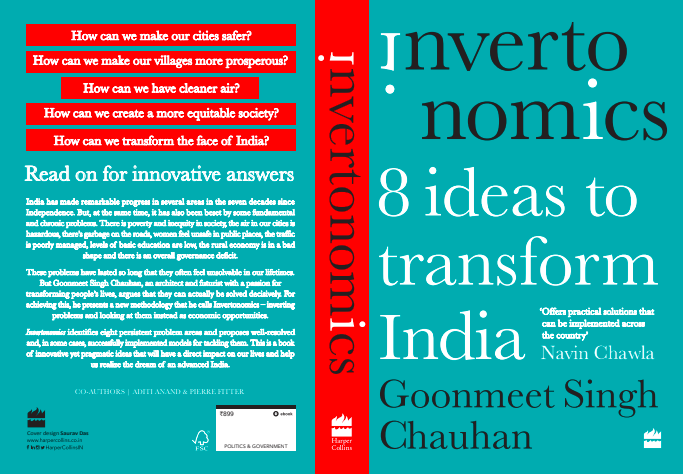‘Invertonomics’-8 ideas to transform India
India is one of the oldest civilizations in the world, with diversity in language, religion and culture, it has been an uphill task for all the ruling governments to tackle various problems of development and civic education. There are policies but sometimes implementation falls flat due to lack of funds or non-compliance and participation by the citizens.
Invertonomics’ authored by Mr. Goonmeet Singh Chauhan, and published by HarperCollins Publishers India, is a new way of looking at problem-solving. This book is a compilation of methodologies that invert problems into economic opportunities. Here the solutions presented have a high index of inclusivity, a common thread that holds the beads of all problems resulting in a single powered comprehensive solution.
The journey to write this book took six years, to untangle the web of problems, starting from micro level to macro level. There are eight transformative ideas as solutions to the common issues in daily life of every citizen, such as, universal access to sanitation, to education, smart garbage management, safer cities for women, and pedestrian safety. Besides the urban issues, there is an upscale model for rural economy as well.
A Sneak peek
The solutions start with the problems of civic sense and habits, that largely affect the minds and human behavior- e.g. honking, biggest menace of modern day travelling that also creates noise pollution. Here a simple solution of fine per honk is presented, that is the beginning of the end to many other issues – The Smart Citizen Card Model
The average ‘honk happy’ driver is accustomed to using the horn at every opportunity, unaware of the nuisance and sound pollution he causes. If, at the end of the month, he were to receive a honk bill charging him for every time he used the horn (at the rate of Re 1 a honk, the bill could be as much as Rs 3,000), he would be likely to become much more ‘honk efficient’.
This is the thread that binds and solves most of the citizen eccentric problems. Some of the other benefits of the Smart Citizen Card as stated are:
- Smart Citizen Card Model automatically reduces opportunities for corruption in the traffic ecosystem: By digitizing the enforcement of traffic rules and minimizing direct contact between the traffic cop and the offending driver
- The Smart Citizen Card Model also brings about a certain institutionalization of transparency and accountability: By means of the Traffic Compliance Bill
- which provides an itemized account of all traffic violations, supplemented with photographs from traffic cameras,
- and giving drivers the opportunity to challenge a fine in case it is unfair or wrong.
An example of revenue generation
Air pollution solution comprises of a modern day tree – taking in polluted air and pumping back clean pure air in a sort of mechanical photosynthesis.
The revenue model works like this- the air purification pillar becomes a supplement to forestation and the Forest Department may prescribe the following measure:
- every time you cut down a tree to make way for a new road or building, not only will you have to plant ten new trees to replace it, you will also have to pay for the installation of two air purification pillars in the same location.
Women Safety Proposal
LEED rating system, which over the last 20 years has revolutionized the green building movement. Similarly the Index for Women’s Empowerment and Safety (IWES) would seek to create a benchmark for the design, construction and operation of safer cities. And also to champion the movement towards ‘women’s empowerment and safety’. It will be using measurement, transparency and connectedness along with monetary incentives to drive change.
Review
As you read through the book page after page, the problems come across as a mind reader and one realizes that actually there is Unity in Diversity– we all have same experiences day in & day out . The solutions presented are well resolved and cogent, relying on graphic communication. It requires the will of some citizens, agencies, organizations, the policy and decision makers, to make this into a reality.
It is one of the best researched and thought of solution finder book of recent times. But it needs to be seen from a very futuristic approach.
- How does one bring about this revolutionary change?
- Are we as citizens ready to participate?
- Is our governance module open to such changes?
These are some of the many questions that need to be addressed. It requires a system change for all states to come under a single window of such agencies, as proposed. If all goes well, it will still take many years to see this kind of India.
Nevertheless, sometimes one idea can bring about the change. It will be very apt to say about the author Mr. Goonmeet Singh Chauhan, in Mahatama Gandhi’s words, “You must be the change you wish to see in the world”. And that’s what is his vision of dream India.
Target readers
It is a suggested read for every citizen to understand, relate and prepare to comply. For the decision makers it will give a direction to implement and generate revenue. Equally important will be to include this book in the curriculum of urban planning, architecture studies, public policy and economics. This will help to prepare the young generation for ideas towards this change. Start-ups or manufacturers will benefit from the book to explore the business ideas.
Overall, I hope we see the end of this pandemic and pick up our dreams of a better future!
Dipika Tuteja
The book is available on:
- https://www.amazon.in/gp/product/9353577357?pf_rd_r=ZYTBKQQ2GJ2YR2AD5915&pf_rd_p=649eac15-05ce-45c0-86ac-3e413b8ba3d4
- https://www.flipkart.com/invertonomics-8-ideas-transform-india-offers-practical-solutions-can-implemented-across-country/p/itm554d01a211710?pid=9789353577353&lid=LSTBOK9789353577353KUP9VL&marketplace=FLIPKART&srno=s_1_1&otracker=AS_Query_OrganicAutoSuggest_1_9_na_na_na&otracker1=AS_Query_OrganicAutoSuggest_1_9_na_na_na&fm=SEARCH&iid=bf183999-bee5-4faf-9c47-90b1e5cb6ff8.9789353577353.SEARCH&ppt=sp&ppn=sp&ssid=09z19ywxeo0000001593103098822&qH=4f1b787926571722
About the Author
Goonmeet is an Urbanist, Architect, and futurist with a vision to bring forth Newness that is both ‘Delightful’ and ‘Useful’. With a focus on creating design with a purpose, he is passionate about transforming the lives of people.



